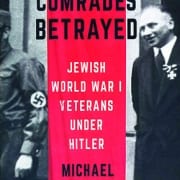Comrades Betrayed: Jewish World War I Veterans Under Hitler
By Sheldon Goldberg, PhD
Between 1914 and 1918, 100,000 German Jews wore the field grey uniform of the Kaiser’s army to fight for Germany. Eighty-thousand served in combat and 12,000 died during the war. They served as enlisted men and officers and many of them were highly decorated. Three aviators were “Aces” and one, Wilhelm Frankl, received the Pour-le-mérite (Blue Max), which is the equivalent to our Medal of Honor. Many others received the Iron Cross 1st or 2nd class and the Wound Badge. The bonds created in the trenches between them and their Gentile comrades lasted for many years after the war.
Michael Geheran, Deputy Director of the Center for Holocaust and Genocide Studies at the U.S. Military Academy has written more than simply another history book about the Holocaust. Using diaries and letters of Jewish World War I Frontkämpfer, those who served in the front lines, and some who survived the Holocaust, he has constructed a social and psychological study of those veterans and how they lived, thought, and survived until virtually all of them were consumed in the Final Solution.
What Geheran underscores is that despite having lost the war, the Jewish veterans did not return disillusioned by the loss and embittered by the anti-Semitism some found, as is conventionally believed. Many returned with their heads held high, believing what they had done in service to the Fatherland would prove their patriotism and see them fully accepted into German society. They were accepted as full members of many of veterans’ organizations formed after the war. Many of them fought with these organizations, such as the right-wing Stahlhelm, against the communists and other revolutionaries attempting to overthrow the Weimar Republic. Jewish veterans, especially those with combat decorations, were held in high esteem.
As the Nazi hold on Germany increased after 1933 and racial laws were implemented, the respect Jewish veterans earned became a double-edged sword. On one hand, it gave them certain privileges not afforded to Jews who had not served. Ordinary Germans would intervene and chastise German police and even the SS for harassing or arresting veterans, especially those who were wounded. They took no stand when it came to actions taken against the other Jews, especially after Kristallnacht, the Night of Broken Glass, in November 1938. On the other hand, resistance and interference from ordinary Germans and, ironically, support for Jewish veterans from highly placed officers in the new German army and government forced the Nazi hierarchy to make compromises that delayed full implementation of the Final Solution. For example, orders were given that exempted decorated and wounded veterans from being transported to the east and death in the concentration camps. This allowed those privileged veterans to maintain their belief that what was happening in Germany would all go away.
However, one by one laws were passed that slowly stripped the veterans of their privileges and reduced them to the level of the other Jews. Then came the establishment of Theresienstadt in 1942 as the destination for decorated and wounded Jewish veterans. Billed as a model ghetto for the privileged veterans, it was a ruse, but one that assured German citizens that the veterans would be in good hands. But it also removed them from society, thus allowing the Final Solution to proceed.
Professor Geheran has written an extremely readable and well-researched book. It makes you proud to read about how these Jewish veterans maintained their sense of honor and military values which allowed them to defy the Nazis in the face of the discriminatory action taken against them. But it’s also sad that so many of those veterans failed to see until it was too late, that under the Nazis, and despite the sacrifices they had made for the Fatherland, they would never be accepted.
Volume 75. Number 1. 2021




